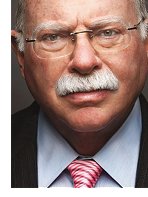 |
From the respected Kirk Report, he has featured Michael Steinhardt's rules of investing which I have pasted below. Kirk himself has come up with 7 rules of his own as well. My comments in brackets.
-----------------------
Kirk Report: Michael Steinhardt is considered one of the most successful hedge fund managers. One dollar invested with Steinhardt Partners LP, his flagship hedge fund, at its launch in 1967 would have been worth $481 when Steinhardt retired in 1995.

He provided six rules in order to become a successful hedge fund manager. Since I think the same apply to all investors, not just those who run hedge funds, I decided to provide them for you as well. They include the following:
1) Make all your mistakes early in life. He says the more tough lessons you learn early on, the fewer errors you make later. A common mistake of all young investors is to be too trusting with brokers, analysts, and newsletters who are trying to sell you bad stocks. (LOL, I had to laugh, not to mock but in total agreement, we all have made our share of mistakes. In my case I have lost more than my net worth and still owed some, thankfully it was when I was in my early 30s, which provided sufficient time to claw oneself back above ground. But how to make sure we make our mistakes early and not later in life? I guess its to remember our failures and not to repeat them. If we always refuse to accept responsibility for our failures, we will be doomed to repeat them. One major flaw in some people is to project their failures on "the lack of luck", or "an unfortunate twist in events" ... all of which is to diminish the ability to own up on our failures, and to attribute blame on others and other things so as to make themselves feel better. We all know so many who fall into that category, and we can almost see how that limits their ability to self-actualise).
2) Always make your living doing something you enjoy. This way, you devote your full intensity to it which is required for success over the long-term.
4) Make good decisions even with incomplete information. In the real world, he argues, investors never have all the data they need before they put their money at risk. You will never have all the information you need. What matters is what you do with the information you have. Do your homework and focus on the facts that matter most in any investing situation. (This is critical as well. I know too many who will wait and wait to gather all information before acting on an investment decision. I am not advocating reckless behaviour but markets will never provide full information. Some will only wait till they have covered 90% of the parameters. Learn to distinguish the really important variables. Learn to make decisions with maybe 60%-70%).
5) Always trust your intuition. For him, intuition is more than just a hunch. He says intuition resembles a hidden supercomputer in the mind that you’re not even aware is there. It can help you do the right thing at the right time if you give it a chance. In fact, over time your own trading experience will help develop your intuition so that major pitfalls can be avoided.
6) Don’t make small investments. You only have so much time and energy so when you put your money in play. So, if you’re going to put money at risk, make sure the reward is high enough to justify it.
* This report was originally published by The Kirk Report on June 2, 2004.
---------------------------In celebration of my 7th anniversary, I would like to share with you 7 simple things I think you can do to improve your performance in the markets for the remainder of the year:
Stop believing the market is logical – The market is primarily moved by both perception and emotion far more than reality or logic. Trade what you see, not what you think you should or want to see. There’s a reason why most people stink at trading as they fail to understand that markets are often illogical and influenced by emotion rather than reality. Whenever possible, try to adopt and hold an “opportunistic” mindset rather than a dominant bullish or bearish posture.
Concentrate your holdings – If you have more than 5 to 10 positions in your portfolio, you are hindering your performance without even realizing it. With the availability of ETFs now, you can diversify as much as you need. Likewise, even if the best of environments, you probably should only be able to find a handful of really good opportunities that offer the most upside with the least amount of risk. Frankly, if you are able to find more than that, then you really don’t understand what it means to find a true low risk/high reward opportunity! (This I agree to a certain extent. As an individual you have to learn to narrow your potshots to less than 5. We all know our aunties who have 20 to 30 stocks, never cutting losses ~ its a meaningless unfocused strategy).
Stop chasing performance – The very best opportunities before you now are in stocks and sectors that no one is talking about or even knows to look at. Likewise, stop looking to chase the hot hand of others. The media and far too many investors are always focused on what is working well now and who is making the most money while the best opportunities are frequently elsewhere. Go where the market is quiet and which no one is interested in and you’ll find more opportunity. In addition, being patient when you don’t find anything that really fits your eye is more than half of the battle.
Turn off the noise – Information may be the world’s most precious commodity, but 99% of the information at your disposal is not. In today’s age of real-time information, opinions, analysis, etc. it is my strong belief that information overload and noise is hindering performance far more than it is helping. The first step is to stop watching all TV and to place severe restrictions on all media. In addition, to perform better this year you must stop wasting time on seeking out advice and opinions that only serve to confirm what you really want to hear in order to justify your positions. If anything, what time you spend in social media should be devoted to looking for ideas that challenge your positions and/or offer unique insight you can really learn something from. (Totally agree. 10 minutes of CNBC a day is more than sufficient. If you go to an hour or more, you would be listening to 10 different experts with 10 opinions, and the anchors will always say to you to stay tuned next as they have another big issue to address).
Understand your limitations and strengths – Not everyone can be a short-term trader nor do they have to be. The mistake that many make is copying another’s strategy that doesn’t fit them nor one they truly understand. This is why they also readily abandon those strategies when the pressure is on which really hurts performance. So, figure out how much time you can devote, what skills you already have, and formulate a strategy that works best for you based on that. Keep in mind also that the best strategies are often so simple that you should be able to explain how they work to those who aren’t intimately involved in the markets.
Accept you will make many mistakes – Those who learn how to minimize the damage when they are wrong and who readily own up to the mistakes they make will do far better over the long haul. Making mistakes is a part of this game, but knowing how to handle them is everything. Likewise, if you attach your ego to your
 portfolio’s performance you are destined for failure. The market absolutely loves to kill those with big giant egos and who look for the markets as a place to prove how smart they are. Markets chew and spit out these folks routinely for good reason and they will continue to do so at every available opportunity.
portfolio’s performance you are destined for failure. The market absolutely loves to kill those with big giant egos and who look for the markets as a place to prove how smart they are. Markets chew and spit out these folks routinely for good reason and they will continue to do so at every available opportunity.Become a specialist, not a jack of all trades – You don’t have to know everything about everything to do well. In fact, those who focus on a specific setup, chart pattern, program pattern, industry group, or even just trade only one ETF frequently perform far better than those who know a lot about a lot of things but have no real discernible edge. I run into people all of the time who know a great many things, but are not an expert of any one thing and that is to their clear disadvantage. So, find something that interests you more than anything else and concentrate all of your time and focus on that one thing. That path will lead you to developing an clear edge that will provide huge profits to you down the line.


















































